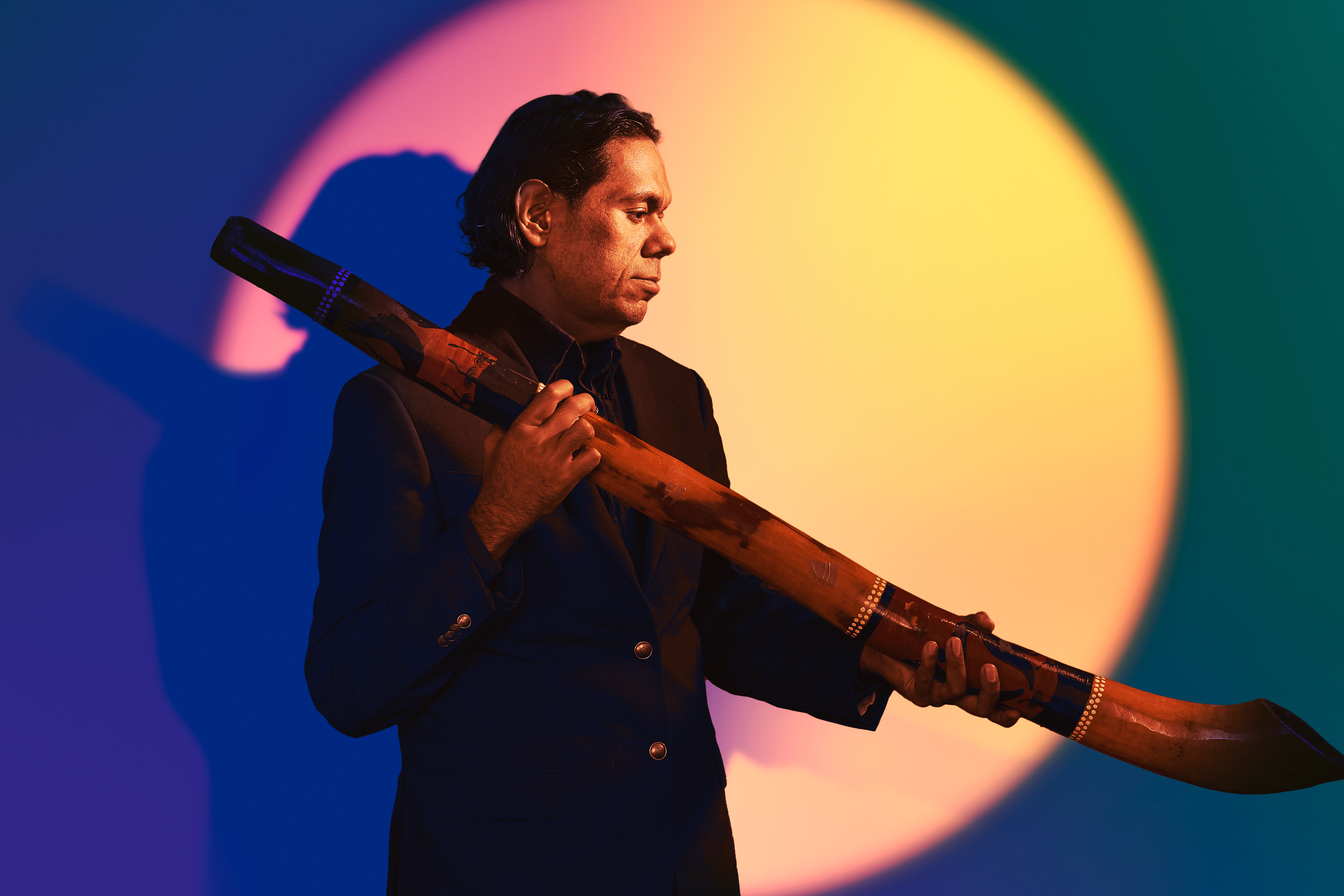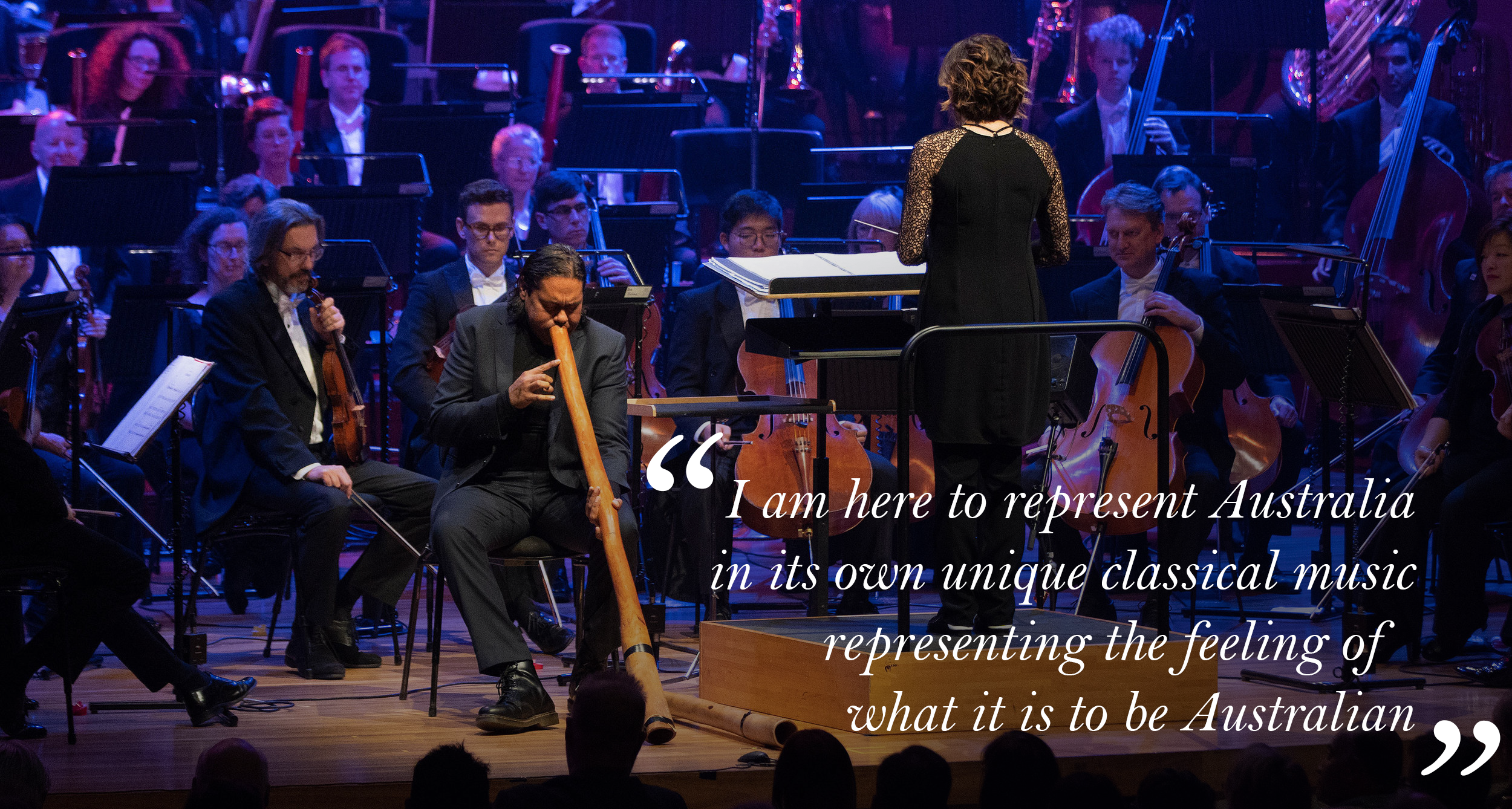"Composing is a conversation" - William Barton Interview

On August 12 the new orchestral work from Australian composer William Barton, The Rising of Mother Country, will receive its European premiere at the Edinburgh International Festival this Autumn. Barton is an exciting new force in the landscape of classical composition: combining talents as instrumentalist, vocalist and didgeridoo player with his compositional craft, his driving passion is to integrate and fuse the indigenous sound realm with western classical music tradition. Wise Music's Promotion Manager in Australia, Catherine Gerrard, sat down with William to discuss his work ahead of his UK visit.
1. Tell us a little about your background and how important music was to you as you were growing up.
I am a proud Kalkadunga descendant. Growing up in Mount Isa, I remember special times on mother country with Mum and Dad and other Elders. At the time I didn’t release this would be the canvas from which I would draw my true musical inspiration.
My whole family was musical. Dad played the guitar and there was always country music on, or jamming sessions around the fire with Dad and friends. There was also the Mount Isa Folk Club where grass-roots instruments such as the Scottish bagpipes, the Irish bodhran drum and the piano accordion were played. I always embraced the opportunity to listen to the song men and women singing the songs of mother country and my Uncle Arthur Peterson playing the didgeridoo.
As a young child, I was fascinated by my own culture. I wanted to learn everything about the living art form of our people and to be a part of the strong connection and legacy. I have fond memories of going to the Kalkadunga Tribal Council, which was run by my Mum and Dad. There I would hear the stories of our ancestors and how traditional techniques were used to care for the country. I was in awe of my Uncle and other Elders and the magical space created when they played traditional Indigenous music. The mysticism completely drew me in. My culture and music are totally integral to my life.
2. How did you come to go down the path of composing music?
I wanted to reflect my genuine connection to mother country by voicing my landscape, the Australian landscape, through music. It was natural to me. The didgeridoo was my first instrument and I found I wanted to translate the rhythms, sounds and melodies of this instrument onto other Western instruments to create a representation of my mother country into a Western classical ensemble. Once I started listening to more classical music, this became more clear to me.
There are only very few composers – such as Peter Sculthorpe – where I could feel they were absolutely in tune with the sounds of nature. I have walked the land and wanted to translate this feeling to music so that others could experience the rugged beauty of the mother country.
3. You have mentioned that you aim to create music that integrates the sounds of your Indigenous heritage with that of the western classical music tradition. Can you talk to us about that?
As a teenager, I had a vision of creating more repertoire for the Western classical world. I saw what others were doing and wanted to add to the legacy; to make a contribution, a statement of Australia’s true national music of the land. In this day and age, we have many mediums and paths in which to interpret music. One of the beautiful things from the Western classical music genre is the collection of symphony orchestra instruments. In their own right, these are pure instruments of the earth. There is a synergy created in playing these instruments, a harmonisation with the body – just as is the case for Indigenous instruments.
Having this quality at your fingertips in composing, there is the chance to simulate and emulate the sound of the landscape through the forces of the orchestral instruments. Through these instruments, the orchestra can become the landscape; reflecting the simple, beautiful yet compilated aspects of the land. Then the orchestra becomes a place of healing because it is depicting mother country, the place where you were born. It's special to create a space and take people on a journey. I am so proud of my Indigenous heritage and I am there for my community, sharing through the sonic forces of orchestral sounds, the Australian landscape. Using these sonic forces to interpret a true national Australian music.
4. When you commence writing a work, what is your process and what are your compositional tools?
I like to have a connection with the commissioner, the people for whom I’m writing. So I start by having a yarn – perhaps over the phone, or face-to-face – to discover the themes and colours of the commission. We have an open conversation about the music. Next, I sit and consciously generate the thought of a place – an image of a landscape like a gorge, or a rocky outcrop with water. Then it’s all about how the brain works – the melody or the pedal notes come from that image.
My next step is a pitch reference that I feel goes best with the image in my mind. I might have a guitar, piano or didgeridoo beside me and I will play a series of chords or harmonies and improvise to find the pitch reference that suits the landscape image in my mind. The pitch reference points and harmonic structure flow to suit the image. My process is to write straight into Sibelius and put down pedal notes, reference points and then a cascade, butterfly effect of motives. As an improviser, I often feel I have too many ideas! However, once I have a steady structure I can concentrate on the theme and notate the key motives for the work.
5. You have written works in a wide range – from small ensembles through to full orchestra with chorus. Do you have a preference in your writing?
I can say I’ve always felt at home writing in the string quartet and string orchestra formats. Being a soloist on didgeridoo with the strings around me is a beautiful intimate feeling. However, even with the power of the full orchestra, I am now starting to feel an equal intimacy with that of the quartet.

courtesy of William Barton
6. Over the last few years there have been premiere performances of a number of your commissioned works including Gift – Our Breath of Life, Apii Thatini Mu Murtu, and The Rising of Mother Country. Can you describe what it is like for you as a composer to bring these works to an audience for the first time?
It’s always a huge honour. That’s the first thing. It is not just a few notes for the musicians to play – it is a connection with the performers, my colleagues, to interpret the landscape for the audience. I want to take the audience on a journey. It is special. For anyone who has that opportunity – it is a powerful experience. There needs to be trust with the musicians, allowing them the ability to express themselves in such a way that they have the space to give their best on their own journey.
7. For people who have not yet heard your works, what can they expect?
Listeners can expect the spirit of Australia, the landscape by which I will always be inspired. As I mature as a musician, the purity and the honesty of what I feel comes through the music even more. Composing is a conversation and I’m able to speak more freely as my musicality evolves. I like to create a space of comfort for people to experience and share in the landscape in a positive light. This is my calling in life.
8. What is your favourite career highlight?
There are three:
- Carnegie Hall in New York, performing Kalkadunga with Adelaide Symphony Orchestra. I was singing in Kalkadunga language, the song I wrote when I was 15. It was all about recognising where I came from. It is a powerful memory.
- Westminster Abbey, performing a didgeridoo solo (which is on my website). I called the solo Kalkadunga’s Journey because I knew it would be broadcast on radio and that therefore, the name of my own country would be stated on air.
- Gallipoli, ANZAC cove – I have been there for the 90th, the 99th and the 100th anniversaries to represent Australia and our fallen soldiers, including our Indigenous soldiers. I have been honoured to perform didgeridoo solos on these occasions.
9. You will soon have works premiered in both the UK and the US. What do you hope to achieve on the international stage?
To continue to connect with all nationalities of the world. The cavass of the music world brings us all together – it is about collaborations and a shared future. I am here to represent Australia in its own unique classical music, representing the feeling of what it is to be Australian.
10. Which composers have influenced you?
Bach is relative to me as a contemporary musician. The melody flow and the rhythms of Bach are appealing as a didgeridoo player. Bach’s moving motives are captivating to me. I am also influenced by Arvo Part and Henryk Gorecki.
11. What are you currently looking forward to?
I’ve been reflecting on my Sydney Symphony Orchestra commission which will be a part of its 50 Fanfares project to herald the reopening of the Sydney Opera House in July this year.
It is important to me and to my mob – not just because of what’s on the inside of the sacred space of the Sydney Opera House, but because of what will be happening on the outside in the sacred landscape too. There, we will honour the country by performing a smoking ceremony in the forecourt for the newly refurbished building. As well, I have worked with the Sydney Symphony Orchestra management to have a large set of clap sticks created from the floorboards of the old and new opera house stages. As a part of the performance, a group of Indigenous children will come out playing the clap sticks. This is a part of the journey.
William Barton will perform Didge Fusion (2012) with the Chineke! Chamber Ensemble at St John's Smith Square on August 10 (book tickets) and the European Premiere of The Rising of Mother Country (2022) at the Queen's Hall on August as part of the Edinburgh International Festival (book tickets).
